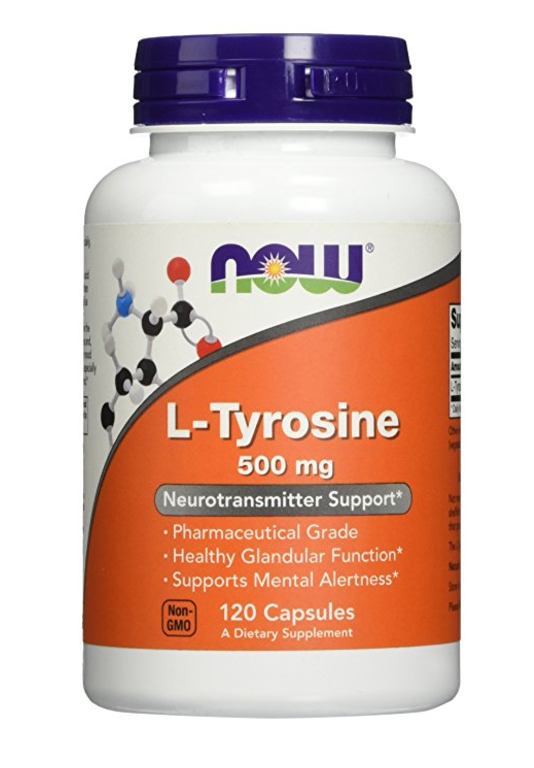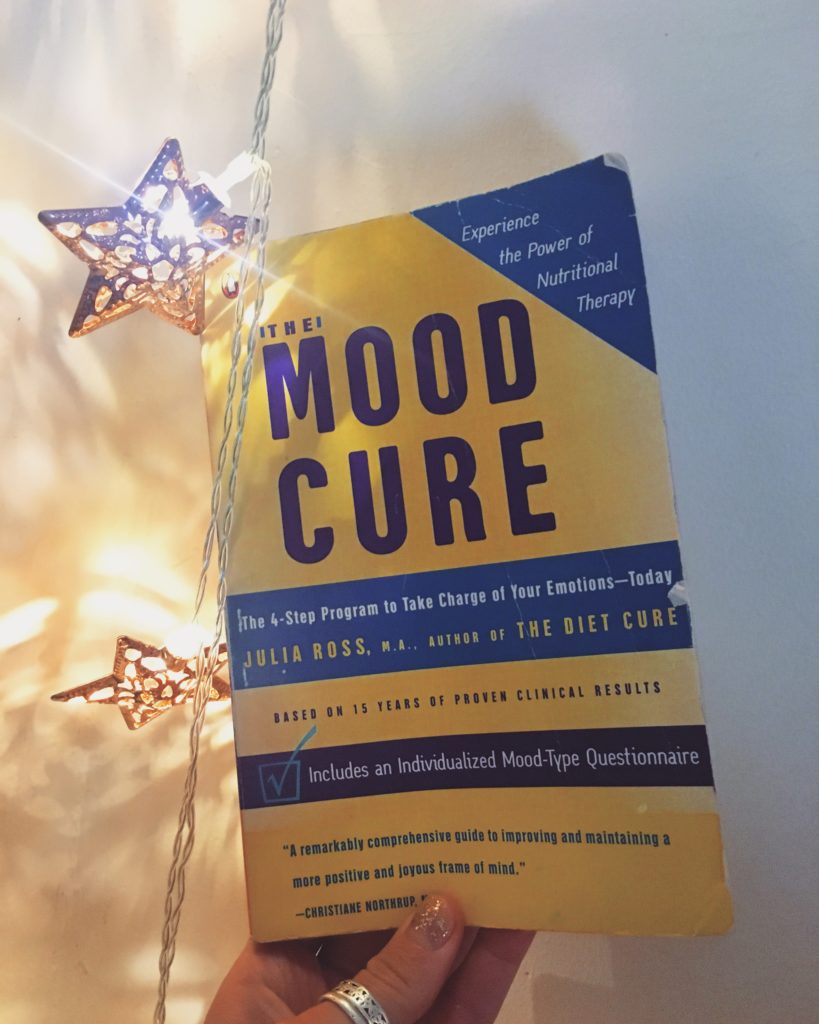Howdy my dear caterpillars,
The Mood Cure is another one of those topics that’s been on my mind to write about for many months. In fact, the first draft of this blog was written in February (although I only wrote the title), and I’m finally getting a chance to sit down and hash it all out for you now.
Before I go on, I must link to my Healthy Crush medical disclaimer again. (I seem to be doing that with every post lately, maybe that means I should just become a doctor instead of continuing to say “remember, I’m not a doctor…”) Hmm. Bottom line, do not take anything from this blog as medical advice, and don’t start a supplement regime without the care of your health practitioner.
I was first reminded of the Mood Cure in one of those roundabout synchronistic ways we get reminded of things. I wrote about Julia Ross, the author, back in 2012, in this post: The Physiology of Addiction.
I heard Julia Ross speak that year at an Integrative Nutrition Conference, and I remember being really immersed in her talk – it was focused on her other book, The Diet Cure.
After the conference though, I didn’t look into amino acid therapy any further, until I was led back to it in 2016.
Studying mood (the topics of anxiety, depression, addiction and energy) is one of the most interesting topics to me in regards to wellness. It’s something I’ve experimented with deeply over the years, and will likely continue experimenting with forever.
Mucuna Pruriens and L-Dopa
A couple of my girlfriends tipped me off last year to a little supplement powder called Mucuna Pruriens, or “the dopamine bean,” which is supposed to be helpful with enhancing mood (when taken in small amounts).
I bought it, and I put it into my cabinet, and the next morning I stirred a little bit into my tea. Soon after, I felt…well, as one Amazon reviewer put it, “it’s akin to the first drippings of tipsiness.” I felt really good, almost questionably good, but I got a headache a few hours later, and I felt like it might be hard for me to figure out the right dosage, which made me a little nervous.
I started thinking. What exactly is this “dopamine bean?”
So I spent the next few hours scouring reddit forums, articles, nootropic forums, and everything I could get my hands on to see what people were experiencing with it.
Turns out Mucuna Pruriens is a source of L-Dopa, the precursor to dopamine.
Dopamine synthesis in the brain:
L-Phenylalanine → L-Tyrosine → L-DOPA → Dopamine
Dopamine
Dopamine is a neurotransmitter (shall we play the Nervous System Song again?) that’s linked to our brain’s pleasure and reward centers, and Julia Ross calls it “the parent cat” (cat being short for catecholamines).
The catecholamines are a group of stimulating brain chemicals – dopamine, norepinephrine and adrenaline. Dopamine produces the other 2 “cats” which is why she called it the parent cat.
Ross says in The Mood Cure, “your sparkle – the feeling of zest and excitement that may be missing from your life – is derived from this trio of supercharged brain chemicals.”
The Mood Cure by Julia Ross
As I got deep into my research about L-Dopa, a few people in the land of internet forums and in Amazon reviews (such a rabbit hole) recommended reading The Mood Cure and mentioned they felt better taking L-Tyrosine instead of L-Dopa.
I knew I had a lot of learning to do. I ordered the book, became fascinated by it, and I spent the next few weeks carrying that book around with me EVERYWHERE.
Julia Ross’s bio:
Julia Ross is a psychotherapist and director of Recovery Systems, a clinic in California that treats mood, eating and addiction problems with nutrient therapy and biochemical re-balancing. She is one of the most successful and well-known names in nutrient therapy, and lectures at conferences and workshops around the world to share her work.
First of all, this clinic she runs sounds like WHERE I WANNA BE, Julia how can I be your apprentice!? It looks like it’s all virtual at this point but man, what I would do to just shadow this woman for a day.
The Mood Cure covers:
- Overcome depression, anxiety, irritability, stress, apathy, oversensitivity, emotional eating and more
- Learn to distinguish between true and false moods
- Eliminate the four most common mood imbalances
- Create a nutritherapy master plan using targeted supplements and good-mood menus and recipes
- Eliminate insomnia, addiction and hormone-related moodiness
- Discover clinically effective nutritional alternatives to antidepressant drugs
Note from Julia Ross at the beginning of the book:
“The nutritional repair tools described in this book are not intended as substitutes for any needed psychotherapy, spiritual guidance or medical care. They are intended to provide additional relief, where appropriate.”
The Four Emotion-Generating Neurotransmitters
I learned quickly that there are four categories of neurotransmitters that help to regulate mood. Those four are serotonin, catecholamines, GABA and endorphins. And these neurotransmitters are fueled by amino acids.
From the book:
“There are twenty-two different kinds of amino acids in high-protein foods like chicken, fish, beef, eggs and cheese. You may have heard them referred to as the building blocks of protein. Each amino has its own name and unique duties to perform, but only a few very special amino acids can serve as fuels for the brain’s four mood engines.
Just five or six of these amino acids, taken as supplements, can effectively reverse all four of the brain deficiencies that cause false moods.”
“False Moods” & Amino Acid Therapy
Julia Ross says that if your brain is “poorly stocked” with amino acids, it will produce “false moods” – you’ve dropped too low in one or more of the key neurotransmitters and your moods will be “defective” as a result.
Here’s an example of how being high and low in the four different neurotransmitters can affect your mood:
-
- High in serotonin = positive, confident, flexible, easy-going
- Low in serotonin = negative, obsessive, worried, irritable, sleepless
-
- High in catecholamines = energized, upbeat, alert
- Low in catecholamines = flat, lethargic funk
-
- High in GABA = relaxed and stress-free
- Low in GABA = wired, stressed, overwhelmed
-
- High in endorphins = full of cozy feelings of comfort, pleasure and euphoria
- Low in endorphins = crying during commercials, overly sensitive to hurt
Amino acid therapy is the practice of using targeted supplementation with the amino acids we’re deficient in to eliminate the “false moods” and get us back to our thriving selves.
The Mood-Type Questionnaire
The best part of this book for me was taking the Mood Type Questionnaire. I was thrilled to find that there’s a version of it here online!
You’ll still have to read the book to get the full explanation of each mood type, but at least that questionnaire can get you started.
I was VERY clear after taking the quiz that I’m low in the “cats.” These are the stimulant neurotransmitters. Ross says people who are low in cats are “almost guaranteed to be drawn to stimulating substances of some kind.”
“Things like chocolate, coffee, caffeine, adderall, cocaine, amphetamines, etc can temporarily increase your cat levels to as much as 1,400%.
Cocaine and amphetamines, for example, both force a huge cat release, but the effects are short lived. These drugs almost inevitably quit giving real satisfaction over time because your brain simply can’t produce enough cats to meet the relentless demand. The ultimate result, cat depletion, is what accounts for long-term withdrawal depression that stimulant addicts experience.”
Of course, like anything else, being low in certain neurotransmitters can be partly genetic and partly due to lifestyle choices, which she goes into depth about in the book.
L-Tyrosine, Depression & Stimulant Addiction
It turned out there was a reason I was so drawn to the dopamine bean I mentioned earlier. I do, in fact, fit the category of low dopamine, but the L-Dopa didn’t seem like the right fit for me.
I have always been drawn to stimulants, always wanting another “hit” of energy, never feeling like I could get enough, always feeling like I shouldn’t be so tired.
I ordered a bottle of L-Tyrosine and I felt an immediate difference. I’ve been taking it for months now and it has changed the way I feel and it’s changed the way I relate to stimulants. In the first few days of taking L-Tyrosine, I felt like I could take or leave coffee, even though I had been drinking it consistently for a few weeks at the time and “needing it” in the morning to wake up. It was subtle, but very noticeable.
This is the L-Tyrosine supplement I’ve been taking.
Julia says, “Tyrosine is a truly phenomenal natural antidepressant. We’ve been successfully using tyrosine to overcome apathetic depression and attention deficits. Typically, it takes only ten or fifteen minutes for this superabsorbable amino supplement to reach the brain and start turning on the lights.”

One of the most noticeable effects for me? Usually when I would get home to NYC from traveling, my friends would laugh at me, knowing that I would need a few days to rest and recover and hibernate before I could see them. After I started taking the L-Tyrosine, though, I had no problem at all not taking those days off of total exhausted hibernation. I could get off a plane and head to have dinner with friends soon after with relative ease. They were shocked. I said, “Seriously, it must be the Tyrosine!” Of course I’d still have the regular tiredness that comes from travel, but it wasn’t such an exhaustion. I felt much better.
I honestly feel like less of an addict in general when I’m taking the L-Tyrosine. Like I said, it’s subtle, but I don’t feel that graspy “I need something to give me energy” feeling the way I did before. And that is really, really cool.
When it comes to getting tyrosine from food to help battle depression, lethargy, ADD or stimulant addiction, Julia says, “protein rich animal-foods are very high in the crucial amino acid tyrosine, but vegetable protein is not.”
She goes on to say,
“There are 900 milligrams of tyrosine in a chicken breast, but you’d have to eat 24 almonds to get a scant 150 milligrams. If you eat a lot of soy-based foods, you run the risk of low cat levels because soy tends to inhibit the conversion of tyrosine into the cats.”
SO INTERESTING. There is so much to learn about our brains and our moods, I can’t even begin to cover it all in a blog post. She covers a ton of food for mood recommendations in the book in deep detail.
I’ve been taking 2 500mg capsules of L-Tyrosine in the morning and another 2 in the afternoon. Julia recommends starting with 1 capsule and if you don’t feel any difference within 30 mins, take another. She says few people need to take more than 2 capsules at a time, unless they have been drinking LOTS of coffee or using stimulants like cocaine.
The Bottom Line
Remember, this is just my experience and me sharing my curiosity on the quest for self-understanding and experimentation. There’s a lot of different information in this book depending on your unique situation, so please take this blog post as simply a guide along your path to possibly reading the book and getting more information about your moods. I am pointing you towards an expert.
Before trying anything or diagnosing yourself with anything, please read the book so you can see all the extra cautions for people with different conditions. You should consult a physician before taking any amino acids, especially if you are taking any medications or have a condition like schizophrenia or bipolar disorder.
I love learning about this stuff, and I love sharing about it. Clearly I get a bit sheepish about sharing anything that could be considered medical information, so I try to do so with caution, but I find it so fascinating, and I feel it’s my responsibility to provide resources that might help you the way they have helped me.
From reading the reviews I can see how many people are being helped by this book and by amino acid therapy.
So if this sparks your interest, well, I have to say, this book is one of those books I keep recommending to everyone. Knowledge is power, my friends. And it’s really empowering to learn a few things about the brain.
Love,
Jenny




beth says
Jenny, how much time does it take to find links to add to your blogs? this blog is very interesting to me. I c ant say I suffer from depression. I am more a heavy soul. Not my nature light and happy. I’m curious about this supplement. Thank you for your research!!! Xo
Angela Nannariello says
Thanks Jenny for the info – love reading your blogs!!!
Jill says
Thanks for this post – very well written. Im also a huge fan of that book. I have also been almost magically cured of horrible moods by simply taking L-Tyrosine. 1000 – 1500 mg a day does ‘er.
Diane says
This is very interesting. My daughter has lost so much cognitive ability since taken off an ssri. Besides looking sad she is in a constant brain fog. MRI and CAT scan are fine. Doctors have no answers so we are searching the natural supplements to help her. Going to try Tyrosine and 5 htp. Using fish oil and turmeric as well. Any other suggestions? Our family is in distress over this. Thnx.
William B says
Great post! Just an FYI that the mood type questionnaire URL has changed – it’s now here: https://www.juliarosscures.com/mood-type-questionnaire/